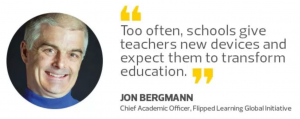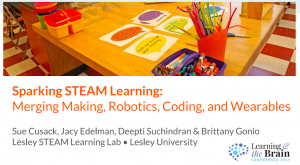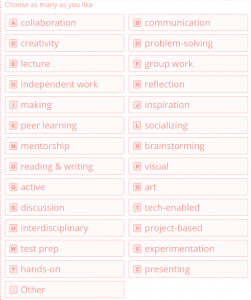Keynote1: Heidi Hayes Jacobs, EdD
Bold Moves for Schools: Creating Modern Learning Spaces, Schedules, and Curriculum
Ending Old-School Nostalgia in Learning Spaces
Keynote2: Mark D. Barnes, MAEd
Hacking the Old School: Reimagining Schools and Classrooms
Hacking the Old School (PPT slides)
Eric D. Klopfer, PhD
From Augmented to Virtual Learning: Affordances of Different Mixes of Reality for Learning
From Augmented to Virtual Learning (slides)
Eric C. Sheninger, MEd
Sheninger, MEd
Learning Transformed: 8 Keys to Design Tomorrow’s Schools, Today
“We need to focus on the “What if’s” instead of the “Yeah buts.”
Our mindsets holds us back
8 Things to Keep in Mind When Executing a Digital Transformation
The role of Leadership
Learn
Empower
Adapt
Delegate
Engage
Reflect
Serve
We learn when we reflect on our experiences.
Don’t prepare them for something, prepare them for ANYTHING!
Classroom design affects learning by 25%
The key to trust is your relationship you create with your kids.
Mark D. Barne s, MAEd, Hacking the Old School: Reimagining School and Classrooms
s, MAEd, Hacking the Old School: Reimagining School and Classrooms
Define: “Eduhacker”
1. Eduhackers see through a different lens.
2. Eduhackers use existing assets in new ways
3. Eduhackers Take action!
Create a Pineapple chart to share/learn what other teachers are doing in their classrooms. Video
Educators need to learn about the “Whole” student, eg. Passions, skills, activities, books, games, family, favorite foods, sports, etc.
360 Spreadsheet to learn about the whole child.
 Jonathan Bergman, MAEd, Learning and Leading in Unprecedented times
Jonathan Bergman, MAEd, Learning and Leading in Unprecedented times
Why are school NOT being disruptive
1. Traditions?
2. Ego, protecting my turf?
3. Culture?


Flip Blooms Taxonomy
Stop fixing the classroom, fix the foundation.
Dr. Robert Dillon (rdillon25@gmail.com) @ideaguy42
Designing Learning spaces that Matter
What Non-Verbals do YOUR classrooms convey?
-How many”NO’s” are posted? No phones, no visitors, no gum chewing, no calculators, etc.
-What are other teachers doing in their classes that interest YOU?
-Replacing old chairs with new chairs in the same formation is NOT enough.
-Purpose driven design
-“Learner focused”, Observe your students, where do they like to “Hangout”, where are they most productive?
-“Learning focused” , Make the classroom FEED innovation and creativity!
-Be careful of too much distractions for students.
-What in your room is NOT being utilized, what is inhibiting learning?
-“Addition by Subtraction”
-Add to the student-centered learning by minimizing clutter in the room.
-Give students space to create and collaborate, space to showcase, space for quiet.
 Susan Cusack and Jacy Edelman Leslie (Teacher prep school)
Susan Cusack and Jacy Edelman Leslie (Teacher prep school)
More than a Maker space, but a “Maker Mindset”
We notice:
– Increase in students’ ability to describe their thinking(metacognition)
– Increase in student engagement with a corresponding decrease in unwanted behavior
The role of the teacher is to create the conditions for invention rather than provide ready-made knowledge
Maker Mindset support interdisciplinary projects
Check out their PDF’s for the session here.
Session 2:
Designing student space in schools
Deep learning experience
Challenging
Any place in the world
Feed back from users? Parents, students, administrators,
Closeups or perhaps virtual pictures may be better?

-Too many descriptors for each scene?
-Build the idea l learning environment
-Prototyping time: Everyone CAN be a designer
-Rubber bands, playdough, tape, brush plants, small cotton balls, paper clips, pens, popsicle sticks

